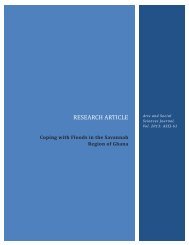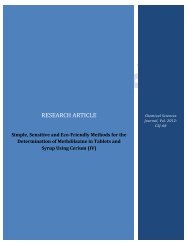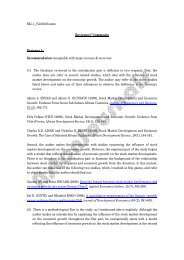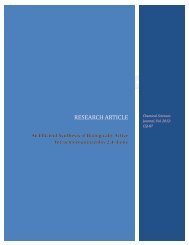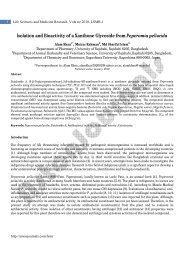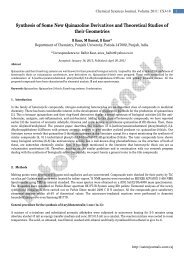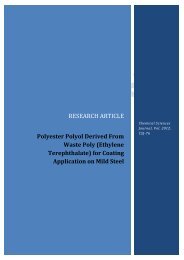Simple and Rapid Spectrophotometric ... - AstonJournals
Simple and Rapid Spectrophotometric ... - AstonJournals
Simple and Rapid Spectrophotometric ... - AstonJournals
Create successful ePaper yourself
Turn your PDF publications into a flip-book with our unique Google optimized e-Paper software.
Absorbance<br />
Absorbance<br />
8 Research Article<br />
3.3.3 Effect of reaction time <strong>and</strong> stability of the C-T complexes<br />
The optimum reaction times were determined by measuring the absorbance of the complex formed upon the<br />
addition of reagent solution to PPL solution at room temperature. The reaction of PPL with PA in method A <strong>and</strong><br />
DNP in method B takes 5 min for complete color development. The absorbance of the resulting C-T complexes<br />
remained stable for at least 2 hrs in method A <strong>and</strong> for about 3 hrs in method B.<br />
3.3.4 Reaction stoichiometry<br />
Job's method of continuous variations of equimolar solutions was employed to establish the stoichiometry of the<br />
PA method <strong>and</strong> DNP method. The solutions of PPL <strong>and</strong> PA equivalent to 2.31×10 –4 M in method A <strong>and</strong> the solutions<br />
of PPL <strong>and</strong> DNP equivalent to 5.78×10 –4 M were prepared in dichloromethane. The solutions were mixed in various<br />
proportions; the volume was completed to the mark with same solvent <strong>and</strong> the absorbance of each solution was<br />
measured at the λ max . The resulting graph (Figure 5) shows that the interaction occurs on an equimolar basis (1:1<br />
reaction stoichiometry), owing to the presence of one basic nitrogen containing group.<br />
0.6<br />
0.5<br />
0.4<br />
0.30<br />
0.25<br />
0.20<br />
0.3<br />
0.15<br />
0.2<br />
0.10<br />
0.1<br />
0.05<br />
0.0<br />
0.0 0.2 0.4 0.6 0.8 1.0<br />
Mole ratio, (V PPL<br />
/V ppl<br />
+V PA<br />
)<br />
0.00<br />
0.0 0.2 0.4 0.6 0.8 1.0<br />
Mole ratio, (V PPL<br />
/V PPL<br />
+V DNP<br />
)<br />
(a)<br />
(b)<br />
Figure 5: Job’s continuous variation plot: (a) [PPL] <strong>and</strong> [PA] = 2.31 ×10 -4 M; (b) [PPL] <strong>and</strong> [DNP] = 5.78×10 -4 M.<br />
3.4 Method validation<br />
3.4.1 Analytical data<br />
The linear regression equations were obtained by the method of least squares <strong>and</strong> the Beer's law range, molar<br />
absorptivity, correlation coefficient, variance, confidence limits for slope <strong>and</strong> intercept for both methods are<br />
summarized in Table 2. The detection limit (LOD) <strong>and</strong> quantification limit (LOQ) were calculated by using the<br />
following equations [38]:<br />
3 &<br />
LOD<br />
. 3<br />
S<br />
10 <br />
LOQ <br />
S<br />
where, σ is the st<strong>and</strong>ard deviation of seven replicate determinations under the same conditions as for the sample<br />
in the absence of the analyte <strong>and</strong> S is the slope of the calibration graph.<br />
3.4.2 Accuracy <strong>and</strong> precision<br />
In order to determine the accuracy <strong>and</strong> precision of the proposed methods, pure drug (PPL) solution at three<br />
different concentration levels (within the working range) were prepared <strong>and</strong> analyzed in seven replicates during<br />
the same day (intra-day precision) <strong>and</strong> on five consecutive days (inter-day precision) <strong>and</strong> the results are presented<br />
in Table 3. The percentage relative error (RE%) was ≤ 1.53 which indicates that the accuracy of the methods is<br />
satisfactory. Percentage relative st<strong>and</strong>ard deviation (RSD%) for intra-day was ≤ 0.93 <strong>and</strong> for inter-day it was ≤ 1.25<br />
indicating repeatability <strong>and</strong> usefulness of the proposed methods in the routine analysis.<br />
http://astonjournals.com/csj



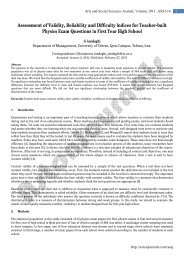
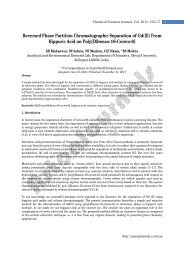
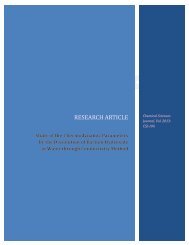
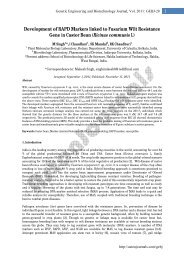
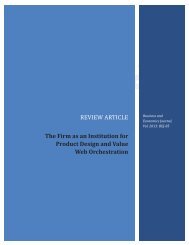
![[1,4]-benzodiazepine-2-one Derivatives as Potent - AstonJournals](https://img.yumpu.com/49117784/1/184x260/14-benzodiazepine-2-one-derivatives-as-potent-astonjournals.jpg?quality=85)
